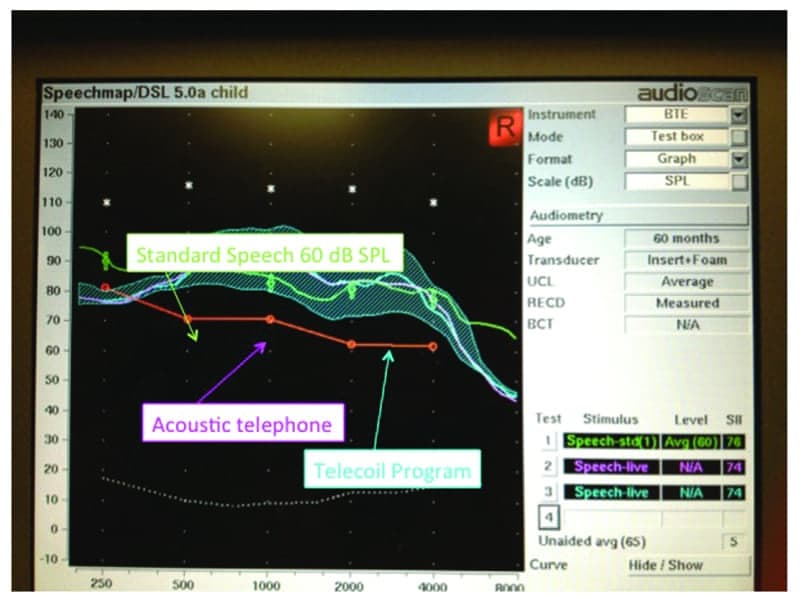Tech Topic: Pediatric Patients & Telephone Use | Hearing Review June 2014
By Jace Wolfe, PhD; Emily Mills; Erin Schafer, PhD; Andrew John, PhD; and Mary Hudson, PhD
Children with bilateral hearing loss typically hear better when listening with two ears compared to one and should, therefore, be fitted with hearing technology (eg, hearing aids and/or cochlear implants) for both ears.1,2 However, little is known about how children could benefit from listening with two ears—rather than one—in other important communication situations, such as hearing on the telephone.
In fact, there is limited knowledge about how children with hearing loss understand speech over the telephone. In particular, there have been no reported studies that have evaluated whether children with hearing loss may understand speech over the telephone better while listening with two ears compared to one.
Recent reports have suggested that adults with significant bilateral hearing loss hear better on the telephone when listening with both ears compared to one. Picou and Ricketts3,4 recently reported on two studies in which they examined recognition of recorded speech presented over the telephone for a group of adult hearing aid users. Specifically, the investigators showed that 16 of 18 adults with moderate-to-severe sensorineural hearing loss achieved less than 50% correct speech recognition over the telephone when assessed in the unilateral condition (ie, the telephone receiver held next to the microphone of one hearing aid). In contrast, this group of adult hearing aid users achieved a 22% improvement when listening with both ears at the same time via wireless streaming that delivered the telephone signal to each hearing aid simultaneously.
Unfortunately, wireless streaming devices are not always available for persons with hearing loss—particularly for young children. These devices typically require an additional investment in technology, and these accessories may not be readily available every time a child chooses or needs to talk on the telephone. Furthermore, wireless streaming accessories are not usually configured to easily interface with most landline telephones but instead are designed to work primarily with mobile devices.
A feature called DuoPhone from Phonak is an alternative solution designed to allow users to hear the telephone signal in both ears simultaneously without the need of an accessory. DuoPhone uses digital, near-field magnetic induction to wirelessly stream audio signals from one hearing aid to the hearing aid on the opposite ear. The user simply holds any landline or mobile telephone next to the hearing aid, and the signal that is captured by the hearing aid microphone or telecoil is wirelessly transmitted from one hearing instrument to the other.
The DuoPhone feature may be used in a manual program (ie, the wearer manually accesses the DuoPhone feature via the program push button or remote control) or as a program that is automatically enabled when a telephone is placed next to the hearing instrument (ie, EasyPhone). Potential benefits of DuoPhone include:
1) The hearing aid wearer is able to receive the telephone signal binaurally;
2) The hearing aid wearer is able to use the telephone naturally with the handset held next to the ear;
3) DuoPhone may be used with any landline or mobile telephone; and
4) DuoPhone requires no special interface equipment.
There are no published studies examining the potential benefits of DuoPhone for pre-school children with hearing loss. As a result, the primary objective of this study was to compare speech recognition in quiet and in noise for a group of pre-school children (ages 2-5 years old) with hearing loss when listening with binaural (DuoPhone) versus monaural telephone input.
Study Design
A total of 10 children, ages of 2 to 5 years (M=3.9, SD=1.0), participated in this study. Study inclusion criteria were as follows:
1) Bilateral hearing loss with a better ear four-frequency pure-tone average between 35 and 75 dB HL.
2) Symmetrical hearing loss with no more than a 20-dB difference in air-conduction thresholds between ears at 500, 1000, 2000, and 4000 Hz.
3) Full-time users of binaural amplification fitted to the Desired Sensation Level Multistage Input/Output algorithm version 5.0 (DSL m[i/o] v5.0, hereafter referred to as “DSL 5.0”) prescriptive targets for children via real-ear probe microphone measures or simulated real-ear probe microphone measures.
4) Spoken English as a primary language.
5) Expressive and receptive spoken language abilities within 1 year of their chronological age as indicated by standardized speech and language assessment conducted within the past year.
Figure 1 displays the average audiograms for the subjects. All subjects were fitted with Phonak Bolero Q90-M13 behind-the-ear (BTE) hearing aids, except for one subject who had a four-frequency pure-tone average of 81 dB HL in the poorer ear and was fitted with Phonak Bolero Q90-SP BTE hearing aids. Digital noise reduction and directional microphone features were disabled for the fitting and for the speech recognition assessment conducted in this study.
The Audioscan RM500SL hearing aid analyzer was used to measure real-ear-to-coupler differences (RECD) for each child. Next, simulated real-ear probe microphone measures were used to ensure that the hearing aid output matched (±3 dB) the DSL 5.0 target for children at 500, 1000, 2000, and 4000 Hz for the Audioscan RM500SL Standard Speech signal presented at 60 dB SPL. Then, the hearing aid was set to the manufacturer’s default “acoustic telephone program” (ie, a telephone program intended for placement of the telephone receiver next to the microphone of the hearing aid-no telecoil).

Figure 2. Simulated real ear output for standard conversational level speech presented from the Audioscan Verifit loudspeaker (Green), for a recorded speech passage presented to the microphone of the hearing aid (Pink) (ie, “Acoustic Telephone”), and for a recorded speech passage presented to the hearing aid telecoil (Blue).
The live speech mode of the Audioscan RM500SL analyzer was used to conduct simulated probe-microphone measure to assess the output of the hearing aid while a recorded speech passage was presented over the telephone. During the procedure, one of the study examiners held the receiver of the telephone handset next to the microphone of the hearing aid. Adjustments were made to the hearing aid gain to ensure that the output of the hearing aid was at least as high as what was obtained to the 60 dB SPL Standard Speech signal (Figure 2).
Next, the hearing aid manufacturer’s default “telecoil telephone program” was enabled with the hearing aid microphone attenuated by 10 dB rather than the software default 0 dB of attenuation for pediatric users. The 10 dB of microphone attenuation was chosen to agree with the ASHA and AAA recommendations of hearing assistance technology guidelines that suggest a 10 dB advantage for the hearing assistance technology inputs.5,6
Once again, the live speech mode of the Audioscan RM500SL analyzer was used to conduct a probe microphone measure to assess the output of the hearing aid for a recorded speech passage presented over the telephone. As before, one of the study examiners held the receiver of the telephone handset next to the body of the hearing aid. Adjustments were made to the hearing aid gain to ensure that the output of the hearing aid matched (±3 dB) what was obtained for the measurement made with the acoustic telephone program (Figure 2). The examiners ensured that the children perceived the recorded speech from the telephone to be comfortably loud.
Speech recognition over the telephone in quiet was measured for all 10 children, and speech recognition over the telephone in the presence of competing noise was measured for 8 of the 10 children (two of the children fatigued before testing could be completed in noise). Speech recognition was assessed in all conditions with a half-list (25 words) of Northwestern University-Children’s Perception of Speech test (NU-CHIPS) open-set words7 presented by the same female talker throughout the study. The intensity of the NU-CHIPS words spoken by the talker was monitored and consistently peaked at 60 dBA as indicated by a sound level meter positioned 1 meter away from the mouth. Speech recognition was evaluated with and without DuoPhone in quiet and also in the presence of uncorrelated classroom noise,8 which was presented at 55 dBA at the location of the subject from four loudspeakers located in the corners of the room. The order in which testing was conducted (eg, monaural vs DuoPhone) was counterbalanced.
Results

Figure 3. Mean NU-CHIP word recognition scores (with 1 SD bar) in quiet and in the presence of noise for the monaural and DuoPhone conditions.
Separate repeated-measures analysis of variance (RANOVA) was used to analyze the results obtained in quiet and in noise because two children were unable to complete the noise condition. Mean word recognition scores in the monaural and binaural phone conditions are provided in Figure 3. The RANOVA revealed a significant main effect of condition for telephone condition in quiet (F[1,9]=88.9, p <.05) and in noise (F[1,7]=24.98, p <.05). In summary, performance with use of DuoPhone in both quiet and in noise was significantly better than performance in the monaural condition.
Discussion
The results of this study have several clinical implications:
1) Pre-school children achieve substantially better speech recognition on the telephone in quiet and in noise when using the DuoPhone compared to their performance in the monaural condition. Overall, recognition of monitored live speech in quiet and in noise improved by about 20%. This improvement is similar to the improvement Picou and Ricketts3,4 reported when comparing binaural telephone performance of adults to monaural use.
2) Simulated probe-microphone measures were used to ensure that the output of the telephone program was appropriate. Similar measures should be considered for clinical purposes to ensure that the telephone signal is audible for young children.
3) When queried about their children’s telephone abilities, many parents reported that their children avoided telephone use because it was too difficult and/or they did not understand how to appropriately use the telephone with hearing aids. Audiologists should devote time to counseling the families of pre-school children regarding strategies for optimal telephone use.
 References
References
1. Beggs W, Foreman D. Sound localization and early binaural experience in the deaf. Br J Audiol. 1980;14:41-48.
2. Litovsky RY, Goupell MJ, Godar S, et al. Studies on bilateral cochlear implants at the University of Wisconsin’s Binaural Hearing and Speech Laboratory. J Am Acad Audiol. 2012;23:476-494.
3. Picou EM, Ricketts TA. Comparison of wireless and acoustic hearing aid-based telephone listening strategies. Ear Hear. 2011;32(2):209-220.
4. Picou E, Ricketts T. Efficacy of hearing-aid based telephone strategies for listeners with moderate-to-severe hearing loss. J Am Acad Audiol. 2013;24:59-70.
5. American Academy of Audiology Clinical Practice Guidelines. Remote Microphone Hearing Assistance Technologies for Children and Youth from Birth to 21 Years. 2011. Available at: http://www.audiology.org/resources/documentlibrary/Documents/HAT_Guidelines_Supplement_A.pdf
6. ASHA. Guidelines for Fitting and Evaluation of FM Systems. 2002. Available at: http://www.asha.org/policy/GL2002-00010
7. Elliott LL, Katz DR. Northwestern University children’s perception of speech (NU-CHIPS): Technical Manual. St Louis: Auditec;1980.
8. Schafer EC, Thibodeau LM. Speech recognition in noise in children with cochlear implants while listening in bilateral, bimodal, and FM system arrangements. Am J Audiol. 2006;15(2):114-126.
Original citation for this article: Wolfe J, Mills E, Schafer E, John A, Hudson M. Binaural hearing on the telephone for pre-school children with hearing loss. Hearing Review. 2014;21(6):14-16.







